Hm, I Feel Like There’s A Big Problem When We Try To Visualize A Sort Of “solarpunk”-like Society
hm, i feel like there’s a big problem when we try to visualize a sort of “solarpunk”-like society where we assume that every place a gonna be a grassy, tree-fillled, green city and that’s like fine and all but it’s very inauthentic to the diverse landscapes of our planet. for example, i live in southern california and ive seen trees and grass but i’ve also seen desert with cacti and bushes and dry land. when we associate our future, our “progress”, with a certain landscape we are not treating the land with the respect it deserves. deserts, plains, mountains, marshes are all apart of the world we live in and we need to invision a future with those lands too
also with all this in mind, a lot of this aesthetic and line of thinking can be damaging to indigenous communities. thinking the desert is just “empty space” and thinking the plains should be replaced with forests go hand-in-hand with colonialist ideology. no land is empty land, it is always someone’s home. we need to make space for indigenous people in our solarpunk, cottagecore, vegan, etc. ideologies if we ever want to truly make progress and not perpetuate the same shit with a different brand on it
More Posts from Green-notebooks and Others






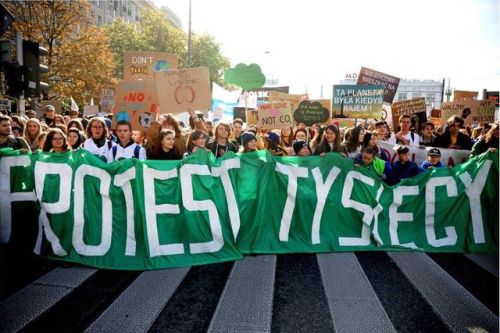



BBC: Millions attend global climate strike
“A global climate strike is under way, with millions of people protesting for “an end to the age of fossil fuels and climate justice for everyone”.”
Can't afford to buy things for your garden?
*Re-posting, with new information
A store-bought bag of topsoil, a roll of landscaping fabric, or a bag of cedar chips doesn’t go very far if you have a large garden or a very limited budget. Here are some ways to create the materials you need for a beautiful, organic, productive garden, by both re-directing household waste, and foraging in your local area. I use a lot of these tricks in my garden to make it almost completely free for me to continue growing new things, and expanding the workable area every year!
For soil
Save your food scraps to create a rich compost for growing veggies and amending your soil. There are numerous options for every size of dwelling and yard. Small space solutions such as Bokashi and vermicompost work indoors and don’t produce bad smells, so you can keep them underneath the sink.Worm towers, compost heaps, and outdoor compost bins are a great solution if you have more space. The more you add, the more rich, nutritious material you can make for your garden. I like composting because it means I don’t have gross smelly garbage bags to deal with, because food waste is diverted. It seems like a lot of work at first, but it actually saves time, money, and transportation.
Seaweed or kelp is one of the best things for your garden, with over 70 essential nutrients, and acting as a weed barrier and a moisture-retentive mulch. I collect seaweed nearby on the beach with my bike trailer, or, when I go for a walk I bring a little home with me each time. It’s an absolute miracle for your soil.

Worm tower
Fertiliser
There are three things that are essential for plant growth. These are nitrogen for leaves and vegetation (N), phosphorus for roots and shoots (P), and potassium for water movement, flowering, and fruiting (K). Commercial fertilisers will give the relative concentrations of each of these compounds with and “NPK” rating. Plants like tomatoes also need calcium to produce healthy fruit. You can create amendments for your garden and soil at home so that you do not have to purchase fertiliser.
For nitrogen
Grass clippings contain 4% nitrogen, 1% phosphorus, and 2% potassium (NPK = 4-1-2).
Human urine contains 12% nitrogen, and it’s sterile. Dilute before adding directly to plants.
Legumes such as beans, clover, peanuts, and alfalfa fix inorganic nitrogen into the soil with mycorrhizal organisms and nodules on their root systems. Plant these crops every few years in rotation with others to renew the soil organically.
For phosphorus
Human urine is also a great source of phosphorous and trace amounts of potassium.
Ground up bones or shells add a slow-release phosphorous to the soil
Had a baby recently? Bury the placenta in the garden.
For potassium
Hardwood ashes
Composted banana peels
For calcium
Break down all of your eggshells, or seashells you have found, in a plastic bucket, using vinegar. This creates a soluble calcium solution you can add to a watering can.
Soil Acidity/Alkalinity
Many plants are particular about what the soil pH should be.
To make soil more acidic: add oak leaves, pine needles, leaf mulch, urine, coffee grounds or sphagnum.
To make soil more alkaline: add wood ash, shell, or bone.
Mulch
Mulch is decomposing organic matter that adds nutrition to the soil, while simultaneously keeping out weed growth and retaining moisture. It also attracts worms, fungi and other beneficial creatures to your soil. Free sources of mulch include:
Leaves
Garden waste
Grass clippings
Straw (often straw bales are given away after being used for decoration in the fall. You can also plant vegetables directly in straw bales using a technique called straw bale gardening).
Wood chips (if you can borrow a wood chipper after you’ve collected some wood you can have attractive wood mulch for free)

Straw bale garden
Landscaping fabric
When mulch isn’t enough to keep the weeds down, many people opt for landscaping fabric. It can be quite expensive and inorganic-looking. Free solutions that both attract worms and can be replaced in small segments as they break down include:
Newspaper*
Cardboard*
Egg cartons*
Printer paper, looseleaf, etc. in thick layers*
*try to make sure you are using paper that has vegetable-based dyes, so you aren’t leeching toxins into the soil.
Soil density/drainage
If your soil is compacted and you have plants that require low levels of water, or excellent drainage, add sand. I don’t recommend stealing it from the beach, but ask around and you’d be surprised at how easy it is to get for free. Sawdust also improves drainage. Adding organic matter and mulch encourages worms, who also till and aerate compacted soil.
If the area still needs drainage, dig a hole and fill it with bricks or rocks to create a “dry well”
For drainage in pots, add crushed bricks, terra cotta pot fragments, packing peanuts, small stones, marbles, orsand to the bottom under the soil layer. I find these in construction sites, on craigslist, or at flea markets.
Pots and growing containers
If you have space, raised beds are a great no-dig way to establish growing space. If you are pressed for space (like working on a balcony) there are many cheap or free options for container gardens.
Creating raised beds allows you to build up the soil without digging. Free ways to do this include using rocks or lumber (like my DIY “lasagna garden” made with the sheet composting technique), using the “wattle“ method with sticks and posts you have found, using discarded straw bales, old bricks,paving stones, cinder blocks or really anything else you have lying around.
Hugelkutur raised beds, which fix carbon and provide drainage, can be made by stacking sticks and untreated wood, and then piling soil or compost over it. (Thanks milos-garden)
Rubber tire gardens retain heat in the night and allow for great drainage. They can also be painted in fun ways.
Herb spirals (here is mine: 1, 2, 3) can be built with stones, bricks, and other found materials.
I often use old cooking pots, barbecues, teapots, or other found objects as planters.
Making wooden planters is easy, and scrap or salvaged wood is also easy to come by. I’m not a fan of using wooden pallets for DIY projects, but they are also a free source of lumber for things like planters.
If you can track down peat moss, cement, and vermiculite, you can make an easy Hypertufa planter in whatever shape you would like, provided you have a form in which it can dry.
I’ve made hanging gardens out of soda cans.
You can build a self-watering container with a 2L pop bottle.
Start seeds in eggshells
Make biodegradable pots out of newspapers.
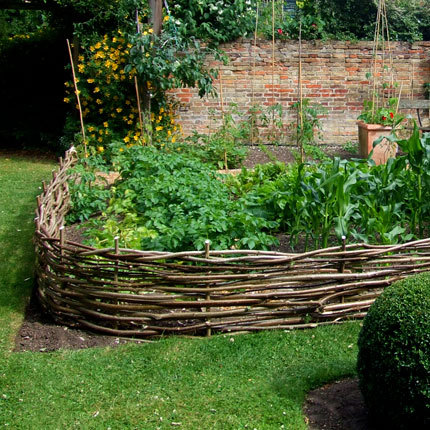
Wattle raised beds

Rubber tire gardens

Hugelkultur

An herb spiral
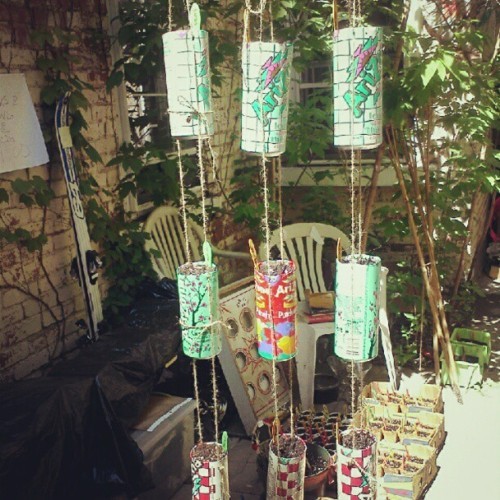
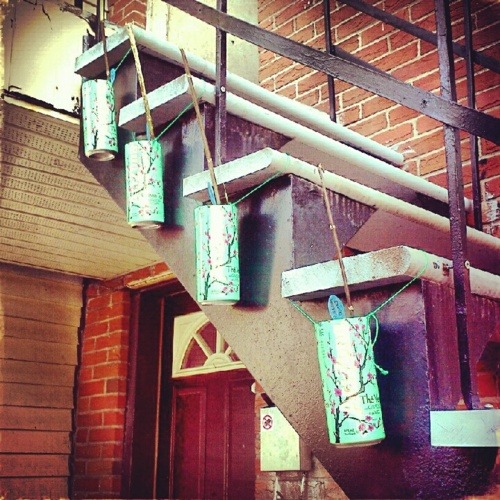
Hanging gardens in cans (2)
Trellises and supports
Many plants need external support, such as stakes of trellises, to thrive.
Rebar can almost always be salvaged cheaply or free and makes a great trellis, arch, or purgola
Build trellises and supports out of the pliable young stems of plants like willow
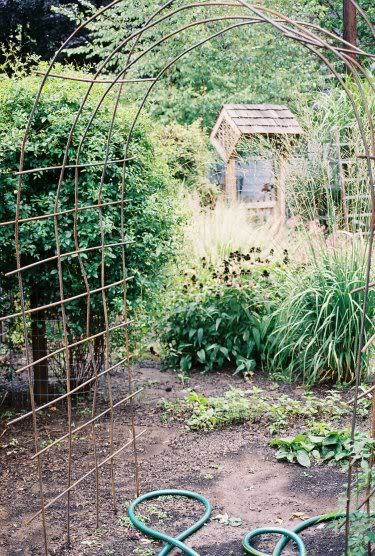
Rebar trellis/arch

Living willow arch/trellis
Paving
Paving often requires a foundation of sand or another stable and well-drained substrate, and a covering of stones, bricks, or other weatherproof elements. Slowly collect stones over time, or free paving stone fragments to create a mosaic-type walkway. Often people give these things away on craigslist. I made a patio and fireplace out of free salvaged bricks, for example.

Salvaged garden walkway
Greenhouses and cold frames
Here is a gallery of greenhouses made out of salvaged windows and doors
A cold frame is easy to make with salvaged lumber, and plastic sheeting.
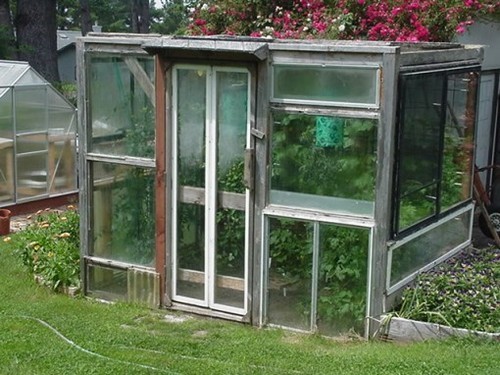
Window greenhouse
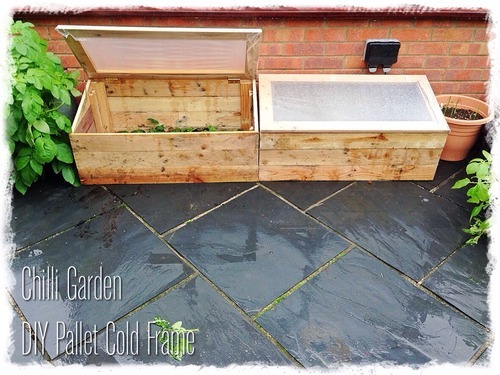
Palet cold-frame
Seeds and plants
Swap seeds with other gardeners
If you see a plant you like at someone’s house, ask for seeds or cuttings
Save seeds every year and build a library of options. Here is a great guide to seed saving.
Save seeds from foods you like from the grocery store: consider growing peanuts, ginger, garlic, peppers, or a walnut tree: all of these and more can be planted from store-bought produce.
Learn to take cuttings. There is a tonne of info on the web about basic cutting propagation, layering, (like I do with rhododendrons) air layering, and numerous other techniques to take clones of plants you like. This saves going to a nursery and shelling out big bucks for all the variety you want.
For cuttings, willow tea and honey are great rooting hormones/antiseptics/anti-fungal agents, which can save you $40 if you were thinking of buying commercial rooting hormone.
You can root cuttings in a potato! (See my methods for rooting “borrowed” plants here)
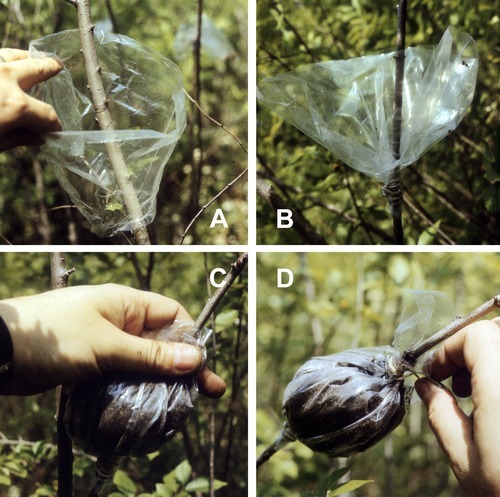
Air layering
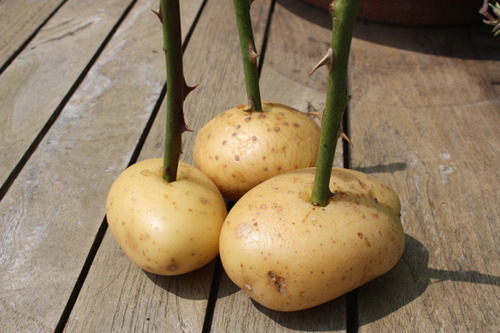
Rooting cuttings in potatoes
—-
I hope this helps you build your garden outside of the usual capitalist channels! It can be a cheap or free hobby if you are willing to think outside the box, and maybe put up with things that don’t look as clean or crisp as a hardware store catalogue. If you have any further ideas, please add them! The more information the better.

“The project was designed to transform a wide, automobile-oriented thoroughfare to a pedestrian-friendly, neighborhood center.
Travel lanes were reduced from five to two while adding five modern roundabouts, improved sidewalks, medians, landscaping, and increased angle parking. Traffic calming measures were installed on less busy side and parallel streets to avoid potential traffic diversion.“
Here’s the before and after:


“Pedestrians once had 70 feet of pavement to cross at intersections. With the roundabouts, they now cross 12–14 feet of pavement at a time with refuge islands in the middle”
“due to the 15 mph design speed of the roundabouts and traffic calming, many bicyclists feel comfortable riding with traffic on La Jolla Boulevard“
“The traffic count remained approximately the same (23,000 vehicles per day before, 22,000 after), but walking, bicycling, transit use, on-street parking and retail sales all climbed to much higher levels, the city reports. Retail sales rose 30 percent and noise levels dropped 77 percent. Because traffic moves slower, businesses report higher visibility.
As a result of the roundabouts and traffic calming, speeds were reduced from 40–45 mph to 19 mph, according to city transportation engineers. “The once busy boulevard has been transformed into a slow-paced street with roundabouts, landscaped street dividers and diagonal parking,” notes the LaJolla Light
Traffic crashes fell by 90 percent. The project has helped revitalize La Jolla Boulevard, acting as a catalyst to several new mixed-use developments, a 139-unit condominium development, and a major drugstore.
“Motorists,” Burden reported in The San Diego Union- Tribune in February 2017, “understandably dreaded this change before it was made. But they found that instead of waiting 24 seconds for a pedestrian to cross 70 feet of road, they now only wait 3–4 seconds, or don’t have to wait at all. Businesses that feared the loss of customers arriving in cars actually improved their trade. … Today motorists are getting to their destinations in less time, because they aren’t stopping.”“
(I’ve added bold for emphasis; the above sections are taken from different parts of the article, click through the link for the whole thing)
This goes to show that designing for a better pedestrian experience is not only safer, but also good for the local economy.
Btw I’m terrified and we are all gonna die and if I hear one more person say “our species destroyed the environment” I’m gonna lose it harder than I already am which is, for the record, Very Hard Indeed



I… I spend a lot of time talking to my husband about climate change.
Politics being what it is, I feel like societal change is where I can find hope. And hey, if we all start making choices based on preparing for an oil-free world, we can actually make oil obsolete!
[On AO3]
Direct air carbon capture is the most egregious bullshit green capitalism has tried to come up with and the fact that anyone who's taken a middle school science class falls for it is astonishing to me
Like, let's just imagine we can build magic carbon capture machines that are made of children's wishes and run on pixie dust and are 100% efficient. It pulls off the scheme carbon capture companies are going after - taking carbon out of the air and turning it into fuel, which is then burned, releasing the carbon back into the air. Even this impossible version of the technology is, at best, carbon neutral
But in the real world, carbon capture needs to use materials, energy, and infrastructure that actually exists, which means that it will always, unavoidably be carbon positive. Unless it breaks the laws of thermodynamics, it can literally never be a solution to the problem
And no matter what kinds of excuses you come up with, no matter how eloquently you argue for different forms of carbon capture and how good you make them sound, none of it fucking matters because we don't need to invent carbon capture. The best way to sequester carbon is to utilize the systems that are doing that already, by restoring ecosystems, restoring soil, and composting. We simply cannot ever be more efficient than nature
But nobody profits off of dirt or prairies, so they've gotta sell you machines that do it instead
no, listen, when I say I want to integrate more specific solarpunk stuff in my life, i don’t mean to ask for yet again new “aesthetic” clothes that now you have to buy or make to show your support of the movement (screw that i’m consuming enough as it is), or more posts about impossible house goals, or whatever, I’m asking you what my options to build a portable and eco friendly phone charger are, im asking you viable tiny-appartment edible plants growing tricks on a budget, im asking tips to slow down when my mind and society tell me im not fast enough, i don’t need more rich art nouveau amateurs aesthetics or pristine but cold venus project, okay, i know i should joins associations where I am tho i’m constantly on the move, thanks for that, just, you know, can we get a bit more practical ??? how do I hack my temporary flat into going off the grid for the time i’m here




earlier this month it was 120 degrees in Australia , but yeah lets continue to mock those trying to save us in the 12 years we have left to slow climate change’s effects.
What is the worst thing that could happen if we listen to scientists and change our ways, and then it turns out they were lying?
Slowly dying in a mad max hell world to own the libs I guess.





I’m trying to write a personal diary about my gardening activities.
-
 could-not-find-good-username liked this · 3 weeks ago
could-not-find-good-username liked this · 3 weeks ago -
 lightabovedecending reblogged this · 1 month ago
lightabovedecending reblogged this · 1 month ago -
 herehaveafandom reblogged this · 3 months ago
herehaveafandom reblogged this · 3 months ago -
 unsungblue liked this · 4 months ago
unsungblue liked this · 4 months ago -
 ohsonder liked this · 5 months ago
ohsonder liked this · 5 months ago -
 kingkhione liked this · 9 months ago
kingkhione liked this · 9 months ago -
 stuffnrandomshi reblogged this · 9 months ago
stuffnrandomshi reblogged this · 9 months ago -
 exerciseinexposure reblogged this · 11 months ago
exerciseinexposure reblogged this · 11 months ago -
 ruqayyashope liked this · 11 months ago
ruqayyashope liked this · 11 months ago -
 ladyimaginarium reblogged this · 1 year ago
ladyimaginarium reblogged this · 1 year ago -
 lunastumblsalong reblogged this · 1 year ago
lunastumblsalong reblogged this · 1 year ago -
 adrimiconlie liked this · 1 year ago
adrimiconlie liked this · 1 year ago -
 musicofthenight321 reblogged this · 1 year ago
musicofthenight321 reblogged this · 1 year ago -
 nathantherock reblogged this · 1 year ago
nathantherock reblogged this · 1 year ago -
 tetrisofficial liked this · 1 year ago
tetrisofficial liked this · 1 year ago -
 oneskys reblogged this · 1 year ago
oneskys reblogged this · 1 year ago -
 oneskys liked this · 1 year ago
oneskys liked this · 1 year ago -
 nihilisticspacequeer reblogged this · 1 year ago
nihilisticspacequeer reblogged this · 1 year ago -
 empidonax reblogged this · 1 year ago
empidonax reblogged this · 1 year ago -
 asheninks reblogged this · 1 year ago
asheninks reblogged this · 1 year ago -
 panickingstudent liked this · 1 year ago
panickingstudent liked this · 1 year ago -
 halfkasster reblogged this · 1 year ago
halfkasster reblogged this · 1 year ago -
 beelzebark reblogged this · 1 year ago
beelzebark reblogged this · 1 year ago -
 rockalillygirl liked this · 1 year ago
rockalillygirl liked this · 1 year ago -
 mannersminded liked this · 2 years ago
mannersminded liked this · 2 years ago -
 roach-works liked this · 2 years ago
roach-works liked this · 2 years ago -
 beelzebark reblogged this · 2 years ago
beelzebark reblogged this · 2 years ago -
 beelzebark liked this · 2 years ago
beelzebark liked this · 2 years ago -
 princepestilence reblogged this · 2 years ago
princepestilence reblogged this · 2 years ago -
 gelquie reblogged this · 2 years ago
gelquie reblogged this · 2 years ago -
 yenoodlethings liked this · 2 years ago
yenoodlethings liked this · 2 years ago -
 referencepostsinfinity reblogged this · 2 years ago
referencepostsinfinity reblogged this · 2 years ago -
 gogogoat495 liked this · 2 years ago
gogogoat495 liked this · 2 years ago -
 1000redwigglers reblogged this · 2 years ago
1000redwigglers reblogged this · 2 years ago -
 smolder-folder reblogged this · 2 years ago
smolder-folder reblogged this · 2 years ago -
 smolder-folder liked this · 2 years ago
smolder-folder liked this · 2 years ago -
 bumblebeeappletree reblogged this · 2 years ago
bumblebeeappletree reblogged this · 2 years ago -
 silverskyy reblogged this · 2 years ago
silverskyy reblogged this · 2 years ago -
 m1lk-ai reblogged this · 2 years ago
m1lk-ai reblogged this · 2 years ago -
 ronan-heitz reblogged this · 2 years ago
ronan-heitz reblogged this · 2 years ago -
 writerslament reblogged this · 2 years ago
writerslament reblogged this · 2 years ago